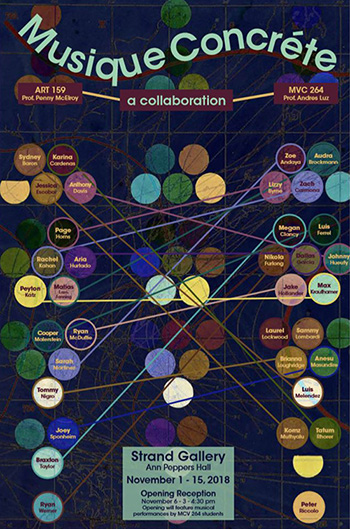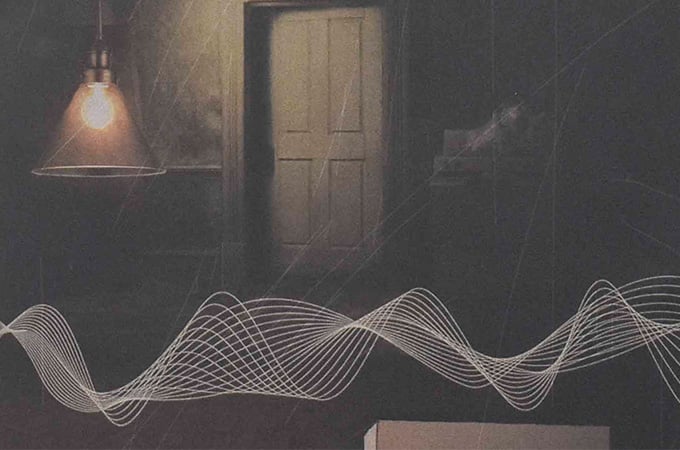When was the last time you attended a music concert outside of a traditional venue? No stage, pit, stadium, or chapel—only the musicians, their instruments, and a visually stimulating backdrop.
Concerts of old, in which musicians played in front of pieces of art so the images and sounds could meld into a work of their own, are what inspired Andres Luz ’16, University of Redlands School of Music graduate and now visiting professor, to reach out to U of R’s Studio Art Department over the summer.
“The course I’m teaching—Digital Sound Composition—had never been offered at Redlands before,” Luz explains. “Sound is a dimension for visual art, and I wanted to teach that to my students through a collaboration with the art department.”
Luz pitched the concept of musique concrète, an experimental type of music constructed by mixing recorded sounds; Professor of Graphic Design Penny McElroy took up his call. “It sounded to me like a great challenge for my Digital Imaging students,” she says.
Digital Imaging is a Studio Art course in which students learn how to create visual art using Adobe Photoshop. Sydney Baron ’20, a student in the course, is thankful for the chance to learn how to create artwork digitally: “For someone who is minimally skilled with hands-on art, such as drawing, painting, and sculpture,” she says, “using technology like Photoshop has given me an opportunity to successfully express my artistic vision.”
Digital Sound Composition may seem like it belongs in the School of Music, but it’s actually a Media and Visual Culture Studies (MVC) course. In order to develop visual competency and media literacy, MVC majors engage in the analysis of television, film, photography, radio, and more. Naturally, MVC students can often be found in studio art courses and vice versa, and some even choose to double major.
The purpose behind Digital Sound Composition is for students to learn the processes of sounds in order to create “cinema sounds,” such as those heard in film and on television. Last spring, the School of Music obtained 24 sound art kits, which allow students to make recordings in the field.
“Each kit consists of a backpack, a microphone, and other recording equipment,” Luz explains, “so the students can record sounds from anywhere. After that, they edit the recordings to make a sound art piece. The intention is to get them familiar with the equipment.”
“I was reluctant to take the course at first,” Dallas Garcia ’20 admits, “but once I made it through my first project, it became fun. The ability to change and transform the sounds I recorded was exciting.”
Garcia shared the inspiration for his sound art piece came to him when he attended this year’s Art Faculty Show and met McElroy, whose work was featured in the show. Garcia found McElroy’s work mesmerizing and, in a somewhat ironic twist, decided to create sounds to compliment her work. “Professor McElroy was so gracious,” Garcia says. “Not only did she let me interview her, but she also let me record her so that I could use her voice and reasoning behind her work for my sound art.”
All of Luz’s students made a sound art piece, and then McElroy’s students each randomly selected one. Some of the visual art students were a bit thrown at first, as most had never heard such music before, but soon they grasped what was being asked of them.
“Professor McElroy specifically told us to focus on how we felt while listening to the music rather than on the literal sounds,” Baron shares. “It turned out to be harder than I expected. The sounds of wind and waves immediately caught my attention, and that’s all I could think about putting into my visual art piece. It took a lot of effort to zone in on the exact feelings I had and translate them into art.”

The collaboration culminated in a show titled Musique Concrète. The visual pieces were displayed in the Strand Gallery in Ann Peppers Hall, and the sound art pieces were played at the show’s reception.
“Everyone has different visions when it comes to abstract pieces of art,” Luz says. “Of course, many of my students were surprised at what the Digital Imaging students came up with, but I think everyone was pleased, overall. I’m grateful the art students were so receptive.”
Baron says that the reception was the perfect way to conclude the assignment: “All my stress about the project was relieved when I could see the connection between my art and the music when it was played in front of everyone.”
McElroy was overjoyed with the results and hopes her students took away a valuable lesson: “The arts can inspire each other.” She and Luz look forward to future collaborations.






